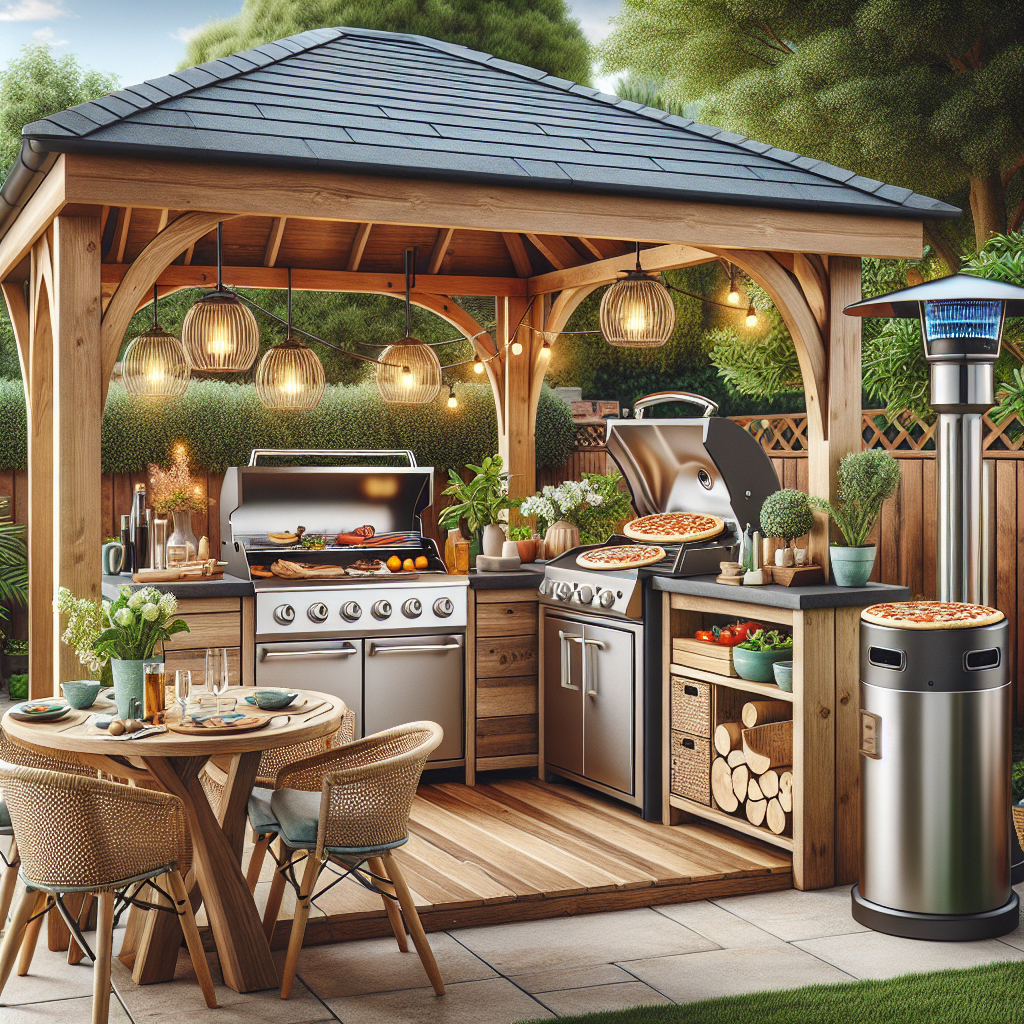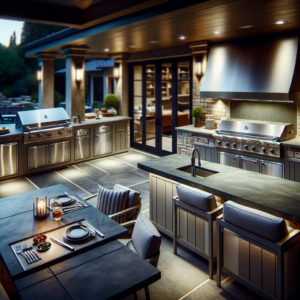
Key Takeaways
- Opt for eco-friendly materials like recycled stainless steel, bamboo, and teak for durability and sustainability.
- Energy-efficient appliances such as solar-powered features and efficient grills reduce your carbon footprint.
- Support local economies and reduce transportation emissions by choosing outdoor kitchen components made in the USA.
- Design your outdoor kitchen with longevity in mind, focusing on materials and appliances that offer a long life span.
- Regular maintenance and proper winterizing techniques are crucial for preserving the sustainability of your outdoor kitchen.
Eco-Friendly Alfresco Dining: Creating Your Sustainable Outdoor Kitchen
Imagine a space where the sizzle of the grill harmonizes with the chirp of crickets, all while knowing you’re treading lightly on the earth. A sustainable outdoor kitchen isn’t just a trend; it’s a lifestyle choice that blends the joys of open-air cooking with an eco-conscious ethos. Whether you’re flipping veggie burgers or searing sustainably caught fish, the right materials and design can make your culinary haven both green and gorgeous.
What Defines a Sustainable Outdoor Kitchen?
A sustainable outdoor kitchen is one that minimizes its impact on the environment. This means using materials that are either recycled or can be recycled, appliances that consume less energy, and designs that are efficient and timeless. Most importantly, it’s about creating a space that can endure the test of time without contributing to waste.
The Perks of Eco-Friendly Materials
Choosing the right materials is at the heart of building a sustainable outdoor kitchen. Eco-friendly materials are not just good for the planet; they offer superior durability and often require less maintenance. Besides that, they can add a unique aesthetic to your outdoor space that speaks volumes about your commitment to the environment.
Top Sustainable Features to Include
When designing your outdoor kitchen, consider these sustainable features:
- Recyclable materials: Opt for countertops and cabinetry made from materials that can be recycled at the end of their lifecycle.
- Energy-efficient appliances: Look for grills and refrigerators with high energy-efficiency ratings.
- LED lighting: Illuminate your space with LED bulbs, which last longer and use less energy than traditional bulbs.
- Water-saving fixtures: Install low-flow faucets to conserve water without compromising performance.
- Non-toxic finishes: Use paints and sealants that are low in volatile organic compounds (VOCs) to keep the air quality in your outdoor space clean.
Green Living: Materials That Last a Lifetime
One of the keys to sustainability is longevity. Choosing materials that can withstand the elements and the test of time means you won’t have to replace them as often, reducing waste and saving resources. Let’s look at some of the best materials for a sustainable outdoor kitchen.

Sturdy Stone Counter Surfaces
Stone countertops are not only elegant; they’re also incredibly durable. Natural stone, such as granite or soapstone, can handle hot pots and pans, resist scratches, and won’t fade in the sun. If you’re looking for a more cost-effective option, engineered stone is another sustainable choice, as it’s made from quartz and recycled materials.
Recycled Stainless Steel Cabinets
Stainless steel is a star in the sustainable materials lineup. It’s not only rust-resistant and easy to clean, but it’s also 100% recyclable. Cabinets made from recycled stainless steel offer a sleek, modern look while ticking all the boxes for an eco-friendly outdoor kitchen.
Renewable Bamboo and Teak Accents
Bamboo and teak are not just buzzwords in the world of sustainable living; they are the cornerstones of eco-friendly design. Bamboo, a fast-growing grass, offers incredible strength and regenerates quickly without the need for replanting. Teak, on the other hand, is a durable hardwood known for its natural resistance to the elements and its ability to age gracefully. Incorporating these materials into your outdoor kitchen not only ensures a reduced carbon footprint but also provides a timeless elegance that synthetic materials can’t match.
- Bamboo cabinetry or cutting boards are a great addition to any eco-friendly outdoor kitchen.
- Teak can be used for everything from countertops to decorative accents, providing a warm, natural feel.
By integrating these materials into your outdoor kitchen, you’re making a statement about your values while also investing in the longevity of your space. Stay tuned for more insights on how to bring your sustainable outdoor kitchen to life with energy-efficient appliances and American craftsmanship.
Cultivating Your Green Space: Choosing the Right Appliances
When it comes to appliances, the sustainability factor lies in energy efficiency. Appliances that consume less energy reduce your carbon footprint and save you money in the long run. But it’s not just about energy consumption; it’s also about choosing appliances that are built to last, reducing the need for frequent replacements and the environmental impact that comes with manufacturing new products.
Therefore, it’s crucial to select appliances for your outdoor kitchen that marry efficiency with durability. Look for energy star ratings and consider the appliance’s full lifecycle – from manufacturing to disposal – to ensure you’re making the most sustainable choice.
Energy-Efficient Grills
The grill is often the heart of the outdoor kitchen, and opting for an energy-efficient model is a smart move. Infrared grills are known for their ability to heat up quickly and cook food more evenly, which means less propane or natural gas is used in the process. Electric grills are another option, especially if you’re able to source electricity from renewable resources like solar or wind power.
Additionally, consider the size of the grill. A smaller grill that suits your needs uses less energy and materials than an oversized one. It’s about finding the right balance for your lifestyle and entertaining needs while keeping sustainability in mind.
Solar-Powered Outdoor Appliances
Solar power is revolutionizing the way we think about energy, and outdoor kitchens are no exception. From solar-powered lights to refrigerators, harnessing the power of the sun can significantly reduce your reliance on non-renewable energy sources. Imagine sipping a cold drink from a fridge that’s been cooled by the sun’s rays – it’s the epitome of sustainable living.
American Craftsmanship: Why Locally-Made Matters
Choosing outdoor kitchen components that are made in the USA isn’t just about patriotism; it’s about sustainability. American-made products often adhere to stricter environmental regulations during manufacturing, which means less pollution and waste. Additionally, by reducing the distance products travel from manufacturer to consumer, you’re cutting down on transportation emissions.
The Benefits of U.S.-Based Production
When you invest in locally-made outdoor kitchen solutions, you’re also supporting fair labor practices and contributing to the local economy. American craftsmen take pride in their work, using high-quality materials and techniques that result in products that stand the test of time. This means less frequent replacements and repairs, which is good for both the planet and your wallet.
Supporting Local Economies with Your Kitchen Purchase
Every dollar you spend on American-made outdoor kitchen components goes back into the local economy, creating jobs and supporting the community. This cycle of support helps to build a more sustainable economy overall, which is an integral part of a sustainable lifestyle. By choosing locally-made, you’re making a positive impact that extends beyond your backyard.
Brick by Brick: Building Your Sustainable Kitchen
Building a sustainable outdoor kitchen starts with thoughtful planning. It’s about more than just choosing eco-friendly materials; it’s about designing a space that maximizes efficiency and minimizes waste. From the layout to the logistics, every aspect should be considered with sustainability in mind.
Planning and Designing for Sustainability
Start with a design that fits your space and needs without excess. Consider the flow of movement and how you’ll use the space. Will you be doing lots of prep work? Include plenty of surface area. Do you love to entertain? Make sure there’s room for guests to mingle without crowding the cook. The goal is to create a functional, efficient space that avoids unnecessary construction and waste.
Installation Tips for the DIY Enthusiast
If you’re handy and looking to reduce costs, consider a DIY approach to installing your outdoor kitchen. Many sustainable materials come with easy-to-follow instructions for the do-it-yourselfer. Just remember to:
- Plan thoroughly before you start.
- Choose the right tools for the job.
- Recycle or repurpose materials whenever possible.
- Seek professional advice when necessary to avoid costly mistakes.
By taking on some of the work yourself, you can ensure that every step of the process aligns with your sustainable values.
After the Build: Upkeep for Longevity
Once your outdoor kitchen is built, maintaining it properly is key to its longevity. Sustainable materials are often low-maintenance, but they still require care to stay in top condition. Regular cleaning, protecting surfaces from the elements, and addressing any wear and tear promptly can extend the life of your outdoor kitchen and prevent waste.

Proper Maintenance of Sustainable Materials
It’s not just about building with sustainable materials; it’s also about maintaining them to ensure they last. Regular cleaning with eco-friendly products, protecting wood surfaces with natural oils, and keeping metal components dry to prevent rust are all part of the upkeep. A little bit of care goes a long way in preserving the beauty and functionality of your outdoor kitchen.
Here are some tips for maintaining different materials:
- Stone countertops: Clean spills quickly to avoid stains, and reseal the surface as recommended.
- Stainless steel: Use a soft cloth and mild detergent to clean; avoid abrasive materials that can scratch the surface.
- Bamboo: Apply linseed or tung oil annually to maintain its natural luster and water resistance.
Winterizing Your Outdoor Kitchen
For those in colder climates, winterizing your outdoor kitchen is crucial. Draining water lines to prevent freezing, covering appliances and furniture, and storing any portable items indoors will protect your investment from the harsh winter weather. This process not only preserves your kitchen’s materials but also ensures that everything is ready to go when warmer days return.
Frequently Asked Questions (FAQ)
As we wrap up, let’s address some common questions about sustainable outdoor kitchens:
What Makes an Outdoor Kitchen Sustainable?
A sustainable outdoor kitchen is designed with the environment in mind. It uses materials that are durable, recyclable, or from renewable resources and includes energy-efficient appliances. It’s also built to last, reducing the need for replacements and minimizing waste.
Can Sustainable Kitchens Withstand Harsh Weather?
Yes, with the right materials and maintenance, sustainable outdoor kitchens can withstand harsh weather. Stone, stainless steel, and hardwoods like teak are all resistant to the elements. Proper winterizing can further protect your kitchen from extreme temperatures and conditions.
Are U.S.-Made Outdoor Kitchen Components More Sustainable?
Often, U.S.-made components are more sustainable due to stricter manufacturing regulations and reduced transportation emissions. Additionally, buying locally supports the domestic economy and can ensure higher quality and longer-lasting products.
How Can I Make My Outdoor Kitchen More Energy-Efficient?
Choose appliances with high energy-efficiency ratings, and consider using solar-powered options where possible. Also, design your kitchen to make the most of natural light, and use LED lighting for evenings.
What Are the Best Sustainable Materials for Outdoor Kitchens?
The best sustainable materials for outdoor kitchens include:



